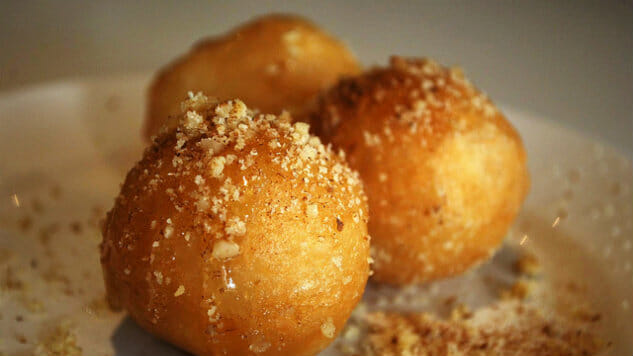Step Aside, Latkes
There's more to Hanukkah than potato pancakes.

Of course there’s nothing wrong with shredded Russet potatoes fried to a golden crisp in a bubbling pool of schmaltz. It’s just that looking around the world, there’s more to the Hanukkah menu—traditional foods that mark the eight-day Jewish Festival of Lights—than the humble potato pancake, known by its Yiddish name, the latke.
But because most American Jews are Ashkenazi Jews, tracing their origins to Eastern Europe or Russia, it’s Ashkenazi foods that dominate the Jewish holidays. Think: latkes, brisket, kugel, and matzah ball soup. This cuisine is rich, kid-friendly, and a bit too sweet, at least for some us defectors.
There’s more to Jewish food, with its lesser-known repertoire for the December holiday. Chances are you haven’t feasted on zalabia or loukoumades for Hanukkah, or fried chicken, couscous, and leek fritters. For Sephardi Jews, whose roots lie around the Mediterranean, in Spain, Portugal, North Africa, and the Middle East, there’s nary a latke for Hanukkah. Sephardi food is Mediterranean food in all its variety and complexity: fresh herbs, ground nuts, and sour flavors that evoke the recipes from Yotam Ottolenghi’s bestselling books.
Hanukkah is a minor event, it’s true, made into a much bigger deal by the proximity (and temptations) of Christmas. This year, the first night of the Jewish holiday falls on Christmas Eve, which only happens three or four times a century. Hanukkah commemorates events that took place more than 2100 years ago, when a group of Jews, led by Judah Maccabee, overthrew their Syrian-Greek occupiers, regained control of Jerusalem, and rededicated the city’s Temple. The Maccabees found enough oil in the temple’s lamps to last 24 hours, but miraculously, the lights glowed for eight days and eight nights. With its message of perseverance, Hanukkah is a classic Jewish story. To remember the oil that kept burning, tradition calls for preparing and eating fried foods, such as latkes.
Or, Bumuelos de Hanuka, fritters made with yeasted dough and aromatic seasonings like anise and fennel seeds, served steaming hot and smeared with honey. Food historians have traced the origins of the bumuelo to Moorish Spain. In the Ottoman Empire, Jewish cooks replaced the seeds in the classic recipe with anise-flavored liqueur, kneading a couple tablespoons of raki, arak, or ouzo into the dough. Claudia Roden, the James Beard Award-winning food writer, explains that Hanukkah fritters in syrup were enjoyed across the Sephardi world. At least a half a dozen names and variations exist, including zalabia in Egypt and loukoumades in Greece. Roden’s masterpiece, The Book of Jewish Food: An Odyssey from Samarkand to New York, weaves together recipes, history, and memoir, covering the cuisine of a people scattered across six continents. But the book tilts toward her own Sephardi culture, which is now concentrated in Israel and France, and to a lesser extent, the U.S. and Argentina, and whose members number 2.2 million, or 16 percent of today’s Jewish population.
While Roden has lived in London for more than 50 years, she remembers the Cairo of her childhood, where Jews from Yemen and North Africa commingled with Jews from the Ottoman Empire, the Balkans, Italy, Syria, and Iraq. Roden’s native Cairo was multicultural and polyglot; its Jewish residents might have switched languages a few times a day, depending on the company. There is no one Sephardi history, Roden demonstrates, and no unifying Sephardi cuisine. “By and large, Italian Jewish food is Italian food,” says Joyce Goldstein, an authority on Sephardi cooking. “Jewish food from what was the Ottoman Empire is very close to Greek and Turkish food, and Jewish Moroccan food is Moroccan food.”
-

-

-

-

-

-

-

-

-

-

-

-

-

-

-

-

-

-

-

-

-

-

-

-

-

-

-

-

-

-

-

-

-

-

-

-

-

-

-

-








































